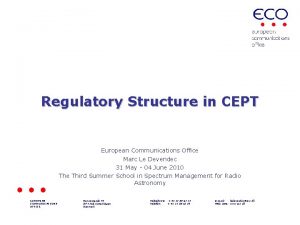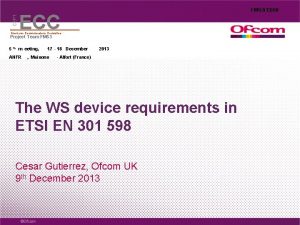European Communications Office Peter Faris peter fariseco cept













- Slides: 13

European Communications Office Peter Faris peter. faris@eco. cept. org 24 -25 October 2017 Antennas Patterns, Positioning and Gain

Antennas in SEAMCAT Antenna angle definitions Specifying antenna patterns – generic systems Specifying antenna patterns – cellular systems Table based antenna patterns Equation based antenna patterns Outline

Antennas in SEAMCAT •

Antenna angle definitions • The antenna pattern is specified relative to the antenna boresight (pointing direction) • It is necessary to map the antenna pattern to the pointing of the antenna which is defined in the “global” co-ordinate system of the scenario: – Azimuth reference: 0 degrees towards “east”, angles increasing anticlockwise – Elevation reference: 0 degrees towards horizontal plane, negative angles below antenna • The angle offset from the antenna towards the point of interest (e. g. towards the VLR) can then be used to calculate the gain • For downtilted antennas, e. g. cellular base stations, SEAMCAT applies co-ordinate transformations

Antenna angle definitions Elevation view Spherical view

Specifying antenna patterns - generic systems • For generic systems antenna parameters are specified under the transmitter and receiver tab

Antenna pointing in generic systems • By default the antenna pointing reference in generic systems is horizontal east • Option to set direct pointing on a link from Tx to Rx, e. g. for fixed links or • • aircraft/satellite tracking scenarios This changes both the pointing and the angle references Additional offsets are also possible

Specifying antenna patterns - cellular systems • For cellular systems antennas are defined under the Positioning tab • It is not currently possible to input a pattern for a mobile station – this is assumed to be omnidirectional by default. • Pointing of base stations is defined by the layout and is fixed

Table based antenna patterns • • • Table based antenna patterns can be defined separately in horizontal and/or vertical planes, or as a spherical pattern (0 to 180 degrees) Antenna patterns can be saved and loaded from the library Creating and editing antenna patterns is similar to editing masks

Combining horizontal/vertical pattern tables •

Spherical patterns •

Antenna patterns specified as equations • Antennas can also be specified with equations and defined as plugins e. g. ITU-R Recommendations • With equation based plugins you only need to specify the peak gain and other defined parameters (e. g. sidelobe level, electrical tilt direction) • The pattern is calculated by SEAMCAT based on the user specified parameters • The following equation based plugins are available in the SEAMCAT library: – ITU-R F. 1336 -4 – ITU-R F. 699 -7 – ITU-R F. 1245 -2 • Beamforming antenna plugins for 5 G systems are under development

Thank you - Any Questions?
 Peter faris
Peter faris European communications office
European communications office Faris alamin hussein
Faris alamin hussein Faris
Faris Perbandingan uang rahmat dan uang faris
Perbandingan uang rahmat dan uang faris Tyhn
Tyhn Office communication server
Office communication server Traineeship office european commission
Traineeship office european commission European personnel selection office
European personnel selection office Edpo gdpr
Edpo gdpr Office and factory
Office and factory Crisis communications working group
Crisis communications working group Tfc t10 coaxial cable
Tfc t10 coaxial cable Nims communications and information management
Nims communications and information management























